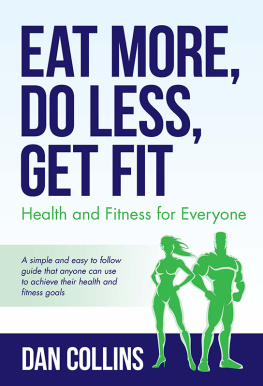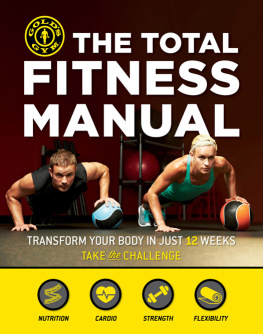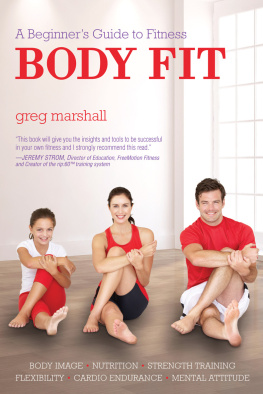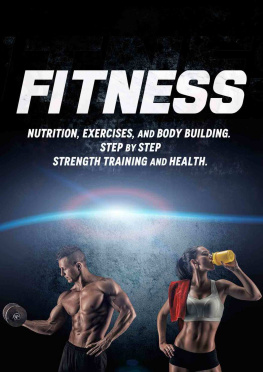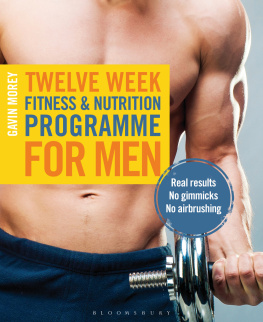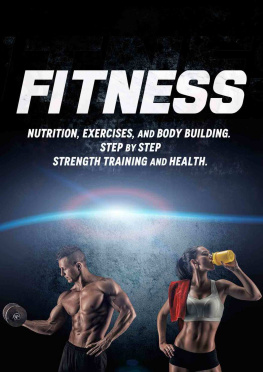Table of Contents

Palmetto Publishing Group
Charleston, SC
Eat More, Do Less, Get Fit
Copyright 2020 by Dan Collins
All rights reserved
All rights reserved. This book or any portion thereof may not be reproduced or used in
any manner whatsoever without the express written permission of the publisher except
for the use of brief quotations in a book review.
First Edition
Printed in the United States
ISBN-13: 978-1-64111-783-8
ISBN-10: 1-64111-783-4
Disclaimer: This is not medical advice. Please consult your doctor before beginning
this or any fitness and nutrition program.
Table of Contents
Written by my dear friend Jeff Brown
The ketogenic (keto) diet and similar diets that have been around for a long time, like the Atkins diet and its progeny, are all over the news now: Want a Better Night's Sleep? The Keto Diet Can Help comparing your height to your weight. And the average person who is one or both of those thingsout of shape and/or overweightwants to do something about it but doesn't know where to start, what to do, or who to believe.
I've known Dan Collins for over forty years. I've worked with and for him as a counselor, advisor, attorney, and friend. (Also as a housepainter and a retail clerk when we were in high school together.) Ever since I can remember, Dan was interested in physical health, wellness, and fitness. As Dan freely admits in this book, Dan was once the stereotypical scrawny teenager at the beach, but the difference between him and most others was that he decided to do something about it. And then he did it. In a remarkably short period of time in his late teens, Dan went from scrawny to substantial, sizeable, and sturdy.
Unlike a lot of people I've known, however, Dan has managed to stay fit and healthy over the past forty years. Most people who meet Dan for the first time guess that he is five to ten years younger (or more) than he really is. I've seen those introductions and surprise reveals with reactions of genuine disbelief, time and again. And that's been increasingly true as we've gotten older.
But there's really no magic here. This is simply Dan doing what his book is saying, walking the walk while talking the talk. The goals set forth in his book are very attainable for the average person. The steps to be taken are most definitely incrementalyou don't read the book, then walk to the mirror and observe transformation on the spot. Instead, Dan gives you all the basic information, written in a straightforward and understandable manner, that you need in order to transform yourself. Then it is up to you. It is always up to you.
If you are interested in a permanent, healthful change, then you owe it to yourself to read this book and follow its advice. I wish and hope for you the best. You must do the rest.
Eat More, Do Less, Get Fit
.
.
.
BMI is calculated as (weight in pounds x 703) (height in inches).
In today's world it seems like everything has to be taken to the extreme. This is especially true in the world of fitness. Extreme diets. Extreme workouts. Extreme results. Well, I am here to tell you that you can accomplish everything you want without having to go to the extreme. Eat More, Do Less, Get Fit is based on the simple idea of combining a healthy, macronutrient-balanced nutrition plan with an appropriate and effective workout routine to Eat More, Do Less, Get Fit!
My goal is to explain the Eat More, Do Less, Get Fit concept using everyday terms and anecdotal examples from my own life to illustrate the concept and provide a foundation for you to do the same. I started my fitness journey long ago when I was just a teenager. Unfortunately, the commonly accepted fitness theory at the time was More is betterthe complete opposite of what I discovered to be true and have now compiled into the Eat More, Do Less, Get Fit vision.
I was the quintessential ninety-pound weakling in my teens. That is when I decided to Get huge. I joined a gym, started lifting weights, and also tried to eat everything in sight, by what was known back then as the See Food Dietif I saw it, I'd try to eat it! The More is better theory applied to nutrition in the same way it applied to training, and it was so far off the mark. Eat More, Do Less, Get Fit explains the error within this practice and the importance of a macronutrient-balanced approach to nutrition planning. Eat More!
Back then everything, and I do mean everything, was More is better. This was applied to any sort of diet plan, workout routine, anything and everything related to fitness. I believe this is where the extreme workout routines began as well. Unfortunately, this is also as far from the truth as you could possibly get. Do Less!
I hope you are as excited about the prospects of an effective yet reasonable health and fitness plan that you can actually do without going to the extreme. By combining a sound nutritional plan along with an appropriate training program, you can achieve your personal health and fitness goals. Eat More, Do Less, Get Fit is exactly that. Get Fit!
Eat More, Do Less, Get Fit will show that the current common thoughts about diet and fitness are simply incorrect. First let's talk diet, or rather nutrition. Then we can add in the training routine which I am sure will surprise you just as much as what I am now going to tell you about nutrition!
Nutrition planning is critical to a successful health and fitness plan. It is the very foundation on which fitness is built, and this statement sums it all up.
Whatever you achieve in the gym will be revealed by what is on your plate.
Diet is typically where most popular fitness plans fail right out of the gate. Most diets rely on a restrictive list of approved foods that do not satisfy your hunger and leave you feeling empty and miserable. Couple that with maniacal workouts like what you see in Peloton commercials or the one-size-fits-all workouts that the personal trainers at most big chain gyms offer, and all you have is a recipe for quittingand who could blame you?
Instead of diet, I prefer to use the term nutrition planning. This is a much more palatable approach where you look at what you are eating and decide how quickly you want to reach the goals you have set for yourself. Then you simply eat your way there.
The biggest mistake I see in most nutrition plans is a misunderstanding of macronutrients, especially when it comes to simple and processed carbohydrates. There is a mistaken belief that eating fat makes you fat. This is so far from the truth. The truth is that eating high-glycemic, simple, processed carbohydrates that cause extreme sugar spikes and crashes is what actually creates body fat. Eating based on a nutrition plan that focuses on balancing the macronutrients that you consume is the key to burning fatnot hours in the gym sweating up a storm, doing endless cardio workouts. Remembereverything you create in the gym will be revealed by what's on your plate.
So, what are macronutrients? These are the basic compounds that are identified on every nutrition label: carbohydrates, proteins, and fats. These nutrients are what food is comprised of, but depending on the specific food, they are distributed in different ratios. For instance, fruits and grains are comprised largely of simple carbohydrates or, more accurately, sugar. Proteins are comprised of amino acids, which are the building blocks of all tissue within your body, especially muscle. And fats are compounds that your body uses to perform various internal functions such as hormone production and maintenance. Each macronutrient serves a very specific function within your body, and the secret to Eat More, Do Less, Get Fit is to eat these macronutrients in the right ratios. By eating them in the correct ratios, you can create the physique that you want. Whether that is to reduce fat and sculpt your body into a lean physique or to build muscle and gain weight. Whatever your goal, you can accomplish it through the Eat More, Do Less, Get Fit program.

